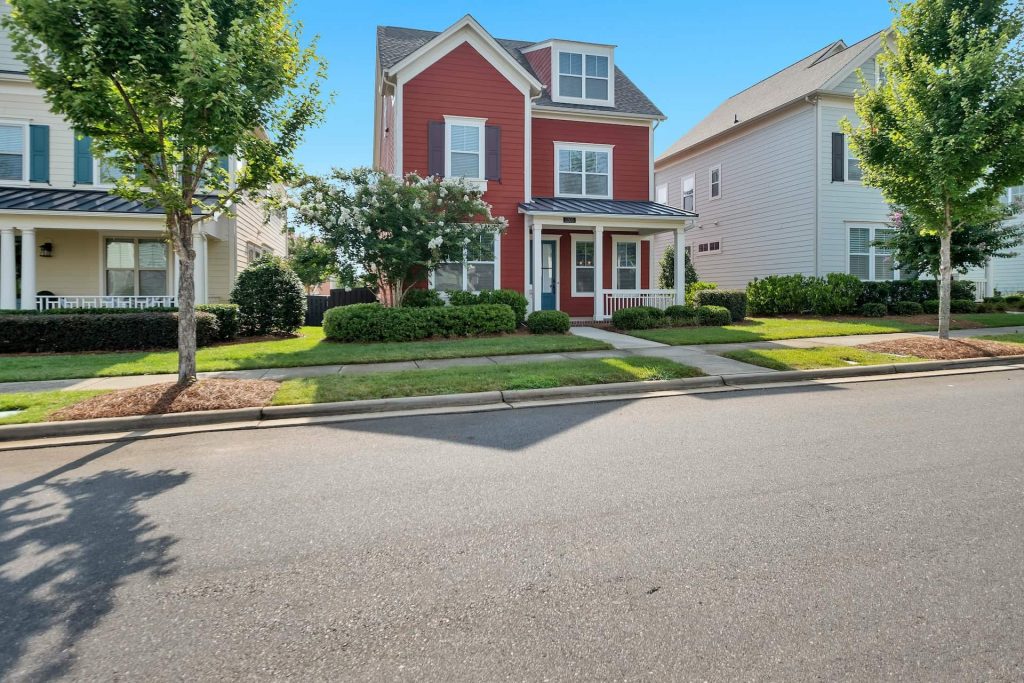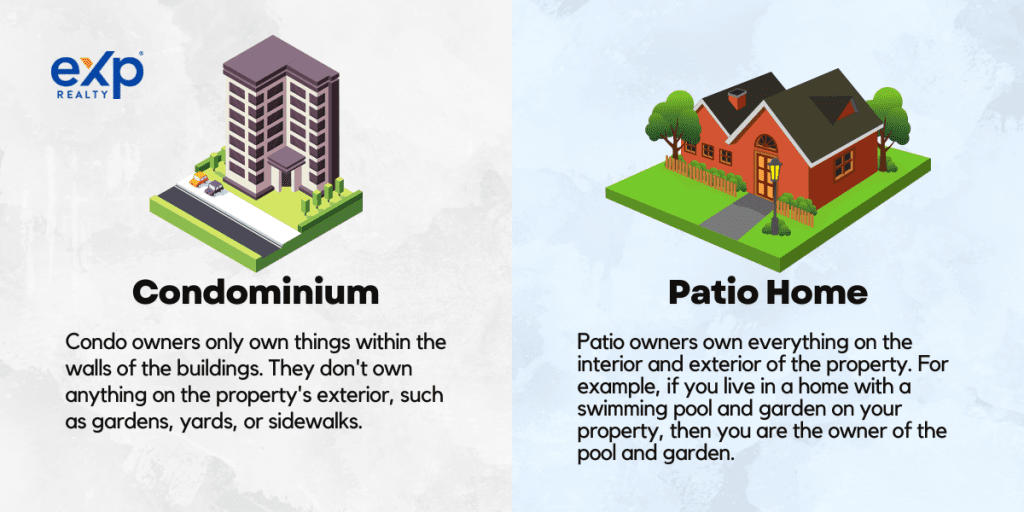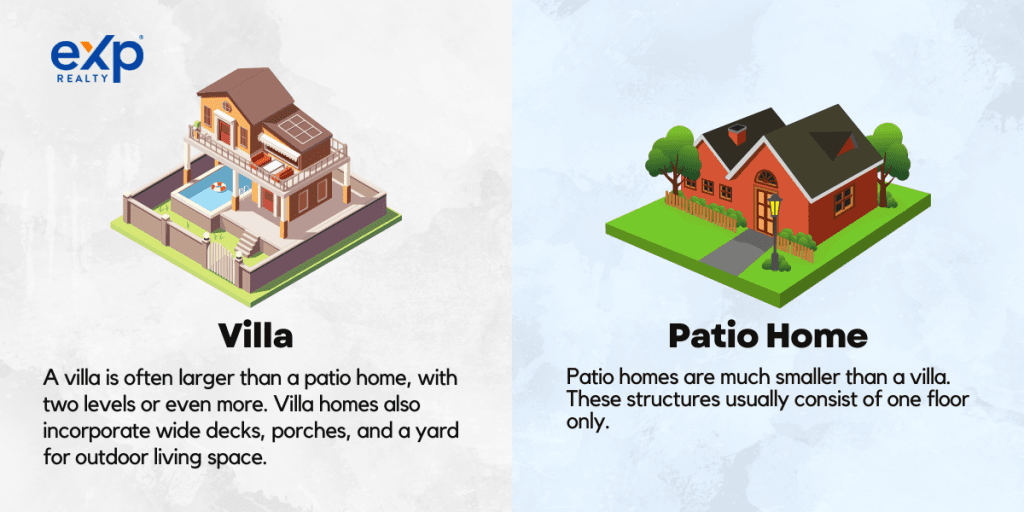The real estate world is an interesting place. It’s always changing, with different trends and buzzwords tossed about, but a few words keep coming up again and again. Among these are patio homes. These houses are quickly becoming popular among first-time buyers and people who live in smaller neighborhoods or common spaces.
But what is a patio home exactly, and how are they different from regular houses for sale? We look at everything you need to know about this unique type of residential property and find out what makes it so special.
What Is A Patio Home?

Patio homes, also commonly known as courtyard homes, carriage homes, cluster homes, or garden homes, are unique types of properties built in a courtyard or a garden. Despite being referred to as a patio home, it’s true that a patio house may or may not incorporate a patio. This home type is instead defined by its style when it comes to architecture and the location of other neighboring houses.
The key feature of a patio home is that it incorporates at least one shared wall between an individual’s home and another living space. This attachment may sometimes come as a gate, exterior landscaping, or fence.
This is the same case with a condominium or a townhouse. However, unlike some condos and townhouses, these property structures are not built to more than one-and-a-half stories. The half-story may be reserved for an extra bedroom or loft, but it’s not something you can consider as an extra floor full of living space.
Patio homes emerged in the 1970s, rising in popularity as they were a preferred home choice among many first-time home buyers. These houses are generally small-lot homes. They are constructed and take up a given property’s entire space/plot.
They are also called “zero-lot lines,” meaning they don’t incorporate a side yard or backyard separating a given home from its neighbors. In many regions, patio homes are constructed near golf courses, although you can still come across them in several residential communities and neighborhoods.
Since patio homes are smaller in square footage than a traditional single-family home, most homebuyers and sellers consider them easy to manage. This feature has made patio homes a common choice for retirees or empty-nesters looking to downsize and needing a low-maintenance place to live in.
However, this doesn’t mean that patio home communities don’t attract other types of people. They are also a preferred option for many first-time buyers looking to invest in a new house but don’t have enough money to invest in something bigger. Or rather, an entry-level buyer looking for an affordable way to own a personal property.
Benefits of a Patio Home
Like many other types of homes, patio homes have their benefits, making them a great option for both new and experienced homeowners. These benefits have prompted more people to choose these properties over others, such as townhouses, single-family homes, or condominiums. Let’s dig deep and find out what these benefits are.
Low Maintenance
One of the biggest advantages of patio homes is their low maintenance features. This advantage is possible because these homes incorporate shared amenities and common areas with neighboring units.

As such, it’s easy to coordinate services such as lawn maintenance and landscaping of green spaces as a community. The combined efforts of the homeowner’s association and hired professionals are enough to keep the property clean, tidy, and well-maintained.
Another aspect that makes patio homes easy to maintain is that they don’t require much yard work. They are small lot homes, so they don’t need much space to make them functional.
Sense of Community
Most people prefer keeping their privacy in mind regarding living arrangements. That’s why there’s no denying some people would rather live alone in a small apartment than share a property with another household. The only problem with living alone is you don’t have anyone to share the little things such as cooking, cleaning, or even sharing common space.
Living in a patio home neighborhood is a great way to make friends and develop a sense of belonging. This feature makes these homes ideal for first-time buyers looking to establish themselves in their new surroundings. Having shared space with your neighbors also allows you to bond and interact, thus helping you feel more comfortable in a new environment.
Affordability
These homes are also more affordable than stand-alone houses or townhouses for a few reasons. Firstly, the property taxes on this type of home are lower than other types, such as single-family homes.
A shared pool, clubhouse, or other amenities also add to the convenience of a patio home. This is because you pay less to use these shared spaces than to maintain and pay for every amenity in an individual unit. Therefore, patio homes are a great option if you are looking for affordable, low-maintenance properties.
Security
Security is one of the most important factors when buying a home. Some people may want to live in a house with a gated pool, driveway, or walkway. Others may want to live in a community with 24-hour security.
At times, homeowners have to pay for additional security measures that are not incorporated into the maintenance fees of their property. Living in a patio home is a good way to keep your expenses down and ensure you have the comfort of having all the necessary amenities as part of your monthly living expenses.
Energy Efficiency
Another good reason patio homes are popular among homebuyers is that they are more energy efficient than regular homes. This is because they don’t have extra room to heat and cool. They also don’t require as much space for a yard. For this reason, patio homes, like small lot houses and condos, are considered more environmentally friendly.
Simple Design
Another great feature of patio homes that makes them a good choice for homebuyers is their simple design. Unlike other types of homes, these properties don’t incorporate fancy features. They are usually small and simple.
However, you can’t deny patio home communities also incorporate architectural styles and interior designs you can’t find in traditional houses. This feature reflects their popularity among homebuyers looking for modern dwellings with simple designs.
A patio home is ideal for downsizing to a small, low-maintenance house. They are designed with everything you need in a small lot home without sacrificing the house style and quality.
Stylish Exteriors
If you are looking for a home that will add style to your neighborhood, then patio homes are a great choice. Nowadays, patio home communities offer different designs and styles to choose from. This aspect is not the same with condos that feature everything similar to each other without a twist.
You can also add a private pool, screened patio, and other luxurious amenities to your property. Furthermore, newer patio homes are designed with modern architectural styles you won’t find in older homes. These home designs can help make your property stand out from the crowd.
Incorporate a Variety of Open Floor Plan Designs
Nowadays, patio homes come with several open floor plan designs, allowing you to customize your house according to your needs and preferences. This feature is ideal for people seeking to customize their homes with personal touches.
With a wide selection of floor plans, you can choose the one that suits your lifestyle, preferences, and needs. This feature allows you to express yourself and make your house a great reflection of who you are.
What Is The Difference Between A Condo And A Patio Home?

As mentioned earlier, patio homes share one similarity with condominiums: they both share a wall with their neighboring units. However, some differences between these two types of properties will assist you in understanding their differences.
But before that, let’s first understand what a condo is to see what makes a patio home different from this type of property.
A condominium unit is a type of home dwelling that shares the same property with other units for various reasons. For example, some developers may build most units next to one another. In this case, each unit has a wall that shares common spaces with its neighbors. Depending on the condo’s size, the owner may incorporate some below, above, or beside the other units.
Other times, a developer may build an entire complex with its facilities. For example, the developer may build a building with a swimming pool, tennis court, and clubhouse. The tenants of this property then have access to their unit plus some common area spaces.
The properties are considered condominiums in both situations because they include several units that share common areas or facilities. Despite the buildings’ similarities, a patio home and a condominium are not always similar.
One significant difference between a patio home and a condominium is their land rights. With a condominium, the condo owners only own things within the walls of the buildings. They don’t own anything on the property’s exterior, such as gardens, yards, or sidewalks.
However, with patio homes, the case is different. Patio owners own everything on the interior and exterior of the property, as well as the lot the property sits on. For example, if you live in a home with a swimming pool and garden on your property, then you are the owner of the pool and garden.
What’s the Difference Between a Villa and a Patio Home?

A villa mainly refers to a one-level structure, often incorporating a front terrace/garden or an exterior patio. Even though most villas are detached, some may share at least a common wall with their neighbors.
Villas are mainly constructed to accommodate a single family. These house types are often a section of gated communities sharing similar styles and designs. They also incorporate similar insurance requirements and maintenance.
The difference between a patio home and a villa is that patio homes are much smaller. These structures usually consist of one floor only. The home entrance usually lacks the height to accommodate a front terrace, although some may incorporate an outdoor deck.
On the other hand, a villa is often larger than a patio home, with two levels or even more. Villa homes also incorporate wide decks, porches, and a yard for outdoor living space.
The other difference is in the amenities each type of home offers. Patio homes incorporate fewer amenities due to their size. They are usually small and lack much storage space. On the other hand, a villa may have more amenities due to its size and the site’s location.
Even though villas have more advantages than patio homes, individuals still choose patio homes over other home types because of their affordability, low maintenance, and customization options. The only drawbacks to patio homes are that they are generally small, lack storage space, and don’t offer privacy like stand-alone homes.
Who Are Patio Homes Suitable For?
If you are considering buying a patio home, then it’s crucial to understand why this type of property is ideal for certain people. When buying a home, consider the property’s cost and maintenance. Patio homes are ideal if you are looking for an affordable home with low maintenance. Most patio homes are cheaper than other types due to their size and shared amenities.
Additionally, patio homes are ideal for individuals looking for smaller, more efficient living spaces. These homes are also ideal for people looking for flexibility in the way their home looks. Patio homes can be renovated to suit your requirements and tastes.
With patios, you also have the advantage of belonging to a community. Once you buy a patio home, you become part of a community where you can enjoy the company of other neighbors. You can also share your facilities and amenities with other property residents.
Furthermore, patio homes are ideal for travel people because they require low maintenance. You can leave for business or family trips without worrying about your home. You can relax and enjoy your trip knowing your home is being taken care of.
Therefore, consider buying a patio home when searching for new properties and are confused about what to settle for.
FAQs
Several questions arise when individuals are considering purchasing a patio home. Before contacting a real estate agent, we’ve answered some of these questions to help you understand more about these homes.
What is the meaning of a patio home?
A patio home is a residential building that consists of several units attached. The structures are generally small and offer limited amenities. They are mostly made up of one floor only and incorporate an exterior area or patio that may lead onto a lawn or garden.
What is another name for a patio home?
Patio homes are also known under several names. They are also called carriage homes, cluster homes, garden homes, or courtyard homes.
Why do they call them patio homes?
They are called patio homes because they incorporate the attachment of other patio homes to their own. This is why they are called cluster homes or courtyard homes. They are also called patio houses due to their architectural design and layout.
Where can I search for patio homes?
If you are searching for patio homes to buy, you should search online. Many online property listing sites will assist you in your search for patio homes for sale. A good example of such a site is https://exprealty.com/properties/.
What’s the difference between a patio home and a villa?
The main difference between a patio home and a villa is its structure. A patio home is small and always consists of a single floor, while villas are large and usually have several floors.
A patio home also has fewer amenities compared to a villa which may have the space to offer you all the amenities you need.
What is the difference between a patio home and a duplex?
While a patio home is considered a single-family home, a duplex is not. A duplex will incorporate two dwelling units you will find under one roof.





